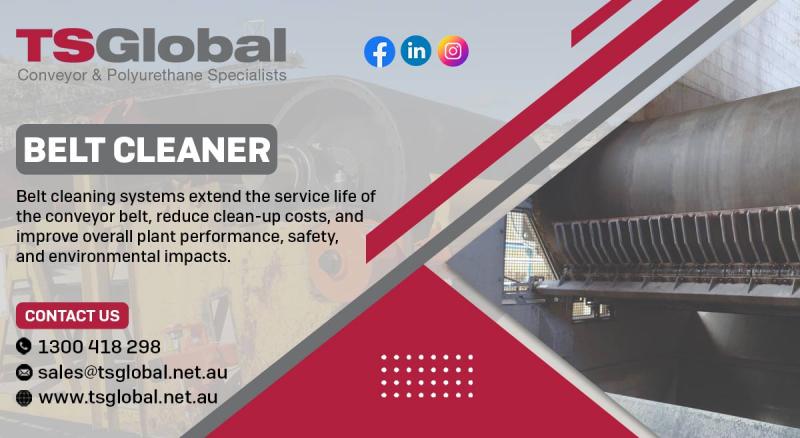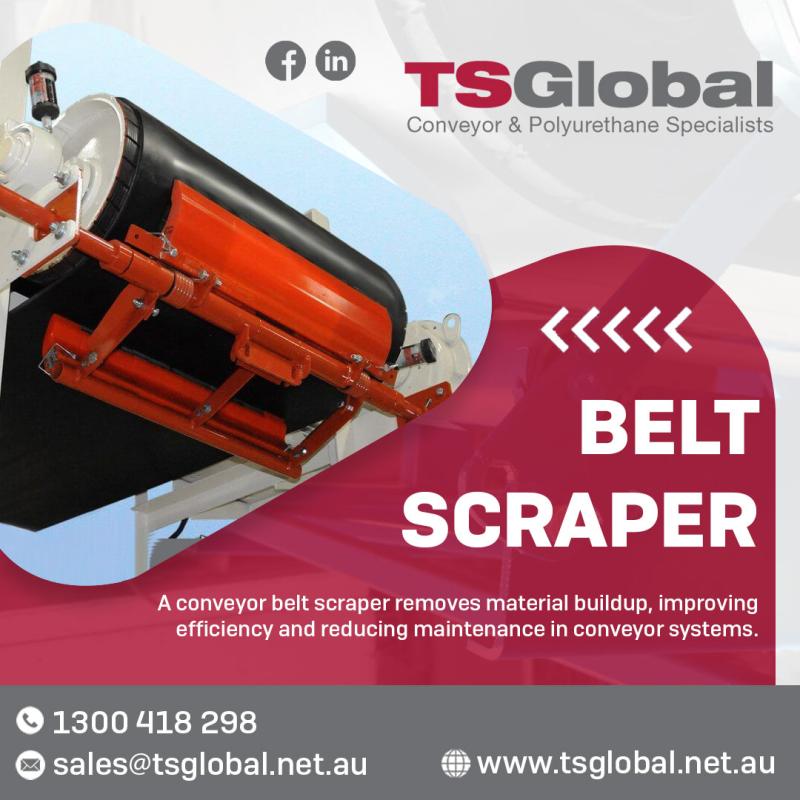Optimizing Conveyor Belts with Effective Belt Cleaners

The Conveyor Belt: Essential for Modern Material Handling
Conveyor belts have revolutionized industries, from manufacturing to
logistics, by facilitating the efficient movement of materials over long
distances. This innovation has become an integral component of operations
worldwide, allowing the rapid transport of products, raw materials, and goods
with minimal human intervention. A conveyor belt is essentially a continuously
moving surface, typically made of rubber, plastic, or metal, driven by pulleys
to move materials from one point to another. The modern conveyor belt system
has evolved to meet various industrial demands, making it indispensable for
businesses looking to optimize efficiency and safety.
A key aspect of the conveyor belt’s
utility is its ability to handle heavy and bulk materials, such as coal, minerals,
grains, or packaged goods, over long distances. It has become a backbone for
industries like mining, agriculture, food processing, and warehousing,
significantly improving the speed of operations and reducing labor costs. But
despite their numerous benefits, conveyor belts require constant maintenance to
ensure smooth operation and long-term durability.
The Evolution of Conveyor
Belt Technology
Conveyor belts have come a long way from their rudimentary beginnings. The
first recorded use of conveyor belts dates back to the late 19th century, with
industrialist Henry Ford being one of the earliest adopters for his automobile
assembly lines. These early systems were simple, manually operated designs made
from leather or fabric that moved materials over short distances. Over time,
conveyor belt technology evolved, with stronger materials like rubber and steel
mesh being introduced, leading to more durable and longer-lasting systems.
The modern conveyor belt system is engineered to withstand extreme conditions
and transport large quantities of material over long distances. Conveyor belts
are now designed with various materials and configurations to meet the specific
needs of different industries. For example, the food industry relies on
conveyor belts made from hygienic materials that meet food safety standards,
while mining industries use heavy-duty belts designed to endure the rough
handling of minerals and rocks.
Increased demand for higher efficiency, combined with technological
advancements, has led to innovations in conveyor belt design, including
automated control systems, sensors, and conveyor belt cleaners that help ensure
the belt operates smoothly and efficiently. Today, conveyor belts are equipped
with safety features, including emergency stop buttons and advanced sensors to
detect jams or misalignments.
The Importance of Conveyor
Belt Maintenance
For a conveyor belt to perform optimally, regular maintenance is crucial.
Conveyor belt systems are exposed to a wide range of materials and environmental
conditions, and over time, wear and tear can lead to a host of issues, such as
belt misalignment, slippage, or damage to the belt’s surface. If not addressed
promptly, these issues can lead to costly downtime, damaged materials, and even
workplace accidents.
One of the most common maintenance tasks associated with conveyor belts is
cleaning. Conveyor belts can accumulate dirt, dust, grease, and other materials
over time, which can affect their performance. A dirty conveyor belt can lead
to reduced efficiency and increase the likelihood of breakdowns. Conveyor belt
cleaning is essential to ensure the smooth and safe operation of the system.
Understanding Conveyor Belt
Cleaners
Conveyor belt cleaners are designed to remove any material or debris left on
the belt after it has discharged its load. These cleaners play a critical role
in maintaining the efficiency of conveyor belts by preventing materials from
sticking to the belt’s surface and causing buildup. If not addressed, this
buildup can lead to various problems, including misalignment, wear and tear,
and reduced belt performance.
There are different types of conveyor
belt cleaners, each designed to suit specific applications and
conditions. The most common types include primary and secondary belt cleaners.
Primary belt cleaners are installed at the head pulley, where the belt leaves
the material handling area, and their primary function is to scrape off most of
the material. Secondary belt cleaners are usually installed further down the
belt to remove any remaining residue that the primary cleaner might have
missed.
Choosing the right type of conveyor belt cleaner depends on several factors,
including the type of material being transported, the conveyor belt's speed,
and the environmental conditions. For example, belts used in mining operations
often require heavy-duty cleaners capable of handling abrasive materials, while
belts used in food processing plants need cleaners made from food-grade
materials to ensure hygiene and safety.
Benefits of Conveyor Belt Cleaners
The use of conveyor belt cleaners offers several benefits for businesses.
Firstly, they help improve the overall efficiency of the conveyor belt system.
By removing excess material from the belt's surface, cleaners reduce the
likelihood of belt slippage and misalignment, leading to smoother and faster
operations. This not only saves time but also reduces wear and tear on the
belt, increasing its lifespan.
Another significant benefit is that belt cleaners help prevent material
carryback, which occurs when materials stick to the belt after being
discharged. Carryback can lead to several problems, including increased
maintenance costs, material waste, and safety hazards. By effectively cleaning
the belt, belt cleaners reduce carryback and its associated issues.
Belt cleaners also contribute to workplace safety. Material buildup on
conveyor belts can pose a serious safety risk, as it can lead to jams,
misalignments, and even conveyor belt failure. Cleaners help prevent these
issues by ensuring that the belt remains free of debris, reducing the risk of
accidents and ensuring a safer working environment for employees.
Types of Conveyor Belt Cleaners and Their Applications
There are several types of conveyor belt cleaners, each designed for
specific applications. The most commonly used types include:
·
Primary Belt Cleaners:
These are the first line of defense against material carryback. Installed at
the head pulley, primary cleaners are designed to remove most of the material
stuck to the belt's surface. They are typically made from durable materials,
such as polyurethane or tungsten carbide, to withstand the tough conditions of
industrial operations.
·
Secondary Belt Cleaners:
Secondary cleaners are used in conjunction with primary cleaners to remove any
remaining material. These cleaners are installed further down the belt and are
particularly useful in applications where stubborn materials, such as sticky or
wet substances, are being transported.
·
V-Plow Cleaners:
These cleaners are mounted on the return side of the conveyor belt and are
designed to prevent material buildup on the belt's surface as it moves back
toward the tail pulley. V-plow cleaners are particularly useful in applications
where large or abrasive materials are being transported, such as in mining or
construction.
·
Rotary Brush Cleaners:
Rotary brush cleaners use a spinning brush to clean the conveyor belt's
surface. These cleaners are often used in applications where fine, powdery
materials are being transported, such as in the food or chemical industries.
The brush helps remove any residue that might be left behind after the belt
discharges its load.
Each type of cleaner has its advantages, and the choice of cleaner depends
on the specific needs of the operation. For example, primary and secondary belt
cleaners are ideal for heavy-duty applications, while rotary brush cleaners are
better suited for fine, powdery materials.
Best Practices for Conveyor Belt Cleaner Installation and
Maintenance
To get the most out of conveyor belt cleaners, proper installation and
maintenance are essential. The cleaner must be installed correctly to ensure
that it effectively removes material from the belt's surface. This includes
ensuring that the cleaner is positioned at the correct angle and that it is in
contact with the belt at the appropriate pressure. Improper installation can
lead to poor performance and increased wear and tear on the belt.
Regular maintenance is also crucial for ensuring that conveyor belt cleaners
continue to function properly. Over time, cleaners can become worn or damaged,
which can reduce their effectiveness. Regular inspection and maintenance help
identify any issues before they lead to costly breakdowns. Replacing worn or
damaged parts, such as blades or brushes, is essential to maintaining the
cleaner's performance and extending its lifespan.
In addition to regular maintenance, it’s important to monitor the conveyor
belt cleaner’s performance. If the cleaner is not removing material
effectively, it may need to be adjusted or replaced. Regular monitoring helps
identify any issues early on and prevents them from escalating into more
significant problems.
Environmental and Cost Benefits of Conveyor Belt Cleaners
The use of conveyor belt cleaners not only improves efficiency and safety
but also offers environmental and cost-saving benefits. By preventing material
carryback, cleaners reduce the amount of material wasted during transport. This
is particularly important for industries that handle expensive or scarce
materials, as reducing waste helps improve profitability.
Additionally, conveyor belt cleaners contribute to a cleaner working
environment. Material buildup on the belt can lead to dust and debris in the workplace,
which can be harmful to employees' health and can also damage machinery. By
keeping the belt clean, cleaners help maintain a cleaner, safer working
environment, reducing the risk of health issues and equipment failure.
From a cost perspective, conveyor belt
cleaners help reduce maintenance costs by preventing material buildup
and wear on the belt. By keeping the belt clean, cleaners reduce the likelihood
of breakdowns and extend the lifespan of both the belt and the cleaner itself.
This results in lower maintenance costs and less downtime, which can have a
significant impact on a company's bottom line.
Conclusion: The Future of Conveyor Belt Systems and Cleaners
The conveyor belt remains a vital component of modern industrial processes,
and as industries continue to evolve, so too will conveyor belt technology.
Conveyor belt cleaners will play an increasingly important role in ensuring the
efficiency, safety, and longevity of conveyor systems. Innovations in
materials, design, and automation are likely to drive the development of more
advanced cleaners capable of handling even the most challenging applications.
As businesses look to reduce costs, improve safety, and minimize their
environmental impact, the role of conveyor belt cleaners will become even more
critical. By investing in high-quality conveyor belt cleaners and implementing
best practices for installation and maintenance,
companies can ensure that their conveyor systems operate at peak efficiency for
years to come







Comments